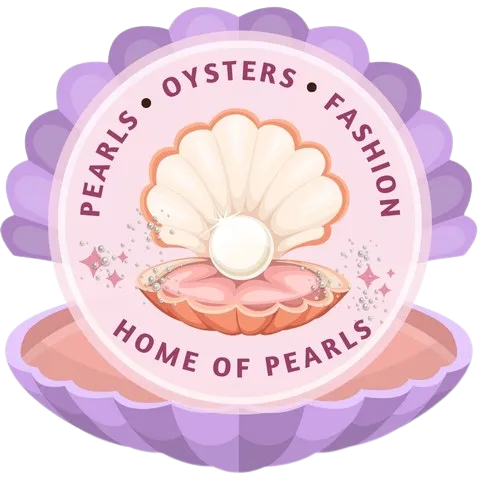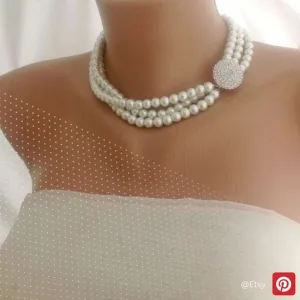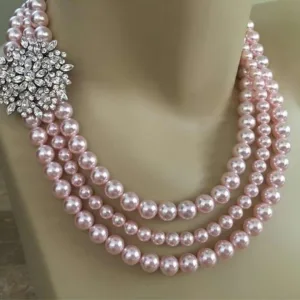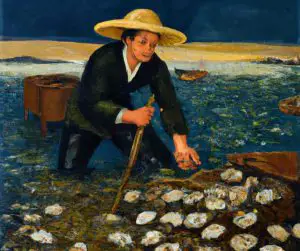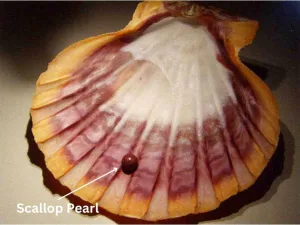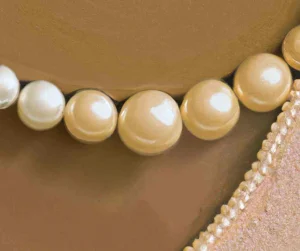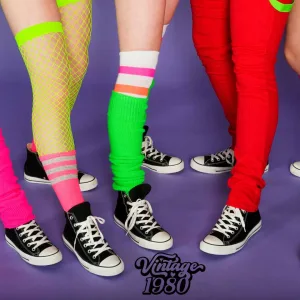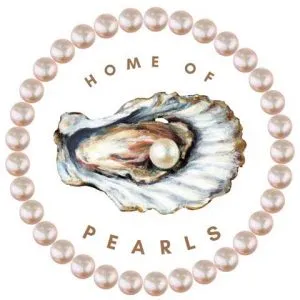To imitate or to copy something implies that the object imitated possesses qualities which are desirable and is therefore worthy of copying. Imitation is said to be the best form of flattery.
Man throughout the ages has copied or imitated precious gems – usually because the rarity and value of the natural products place them beyond the grasp of ordinary men.
‘Perfected by nature and requiring no art to enhance their beauty, pearls were naturally the earliest gems known to prehistoric man’ – The Book of Pearl. The imitation of pearls by man is a token of esteem in which natural pearls continued to be held.
The early imitations were ‘pearl’ colored. The imitation of colored natural pearls came later as man began to increase his appreciation and knowledge of the varieties of and colors of pearls.
In the early days following the discovery of America and of Cortez’s conquistadors, the existence of fantastic hoards of pearls was recorded. The rough seamen and soldiers alike would seize these collections and label them as ‘pearls’.
It is now known that although many were indeed pearls, there were frequently among them beads of spheres of mother-of-pearl cut from the thickest part of the shell. These must rank as examples of the very earliest imitations.
It is understandable that the natives who cut and polished them did so because of the attractive nacreous nature of the shell and it was, of course, the carapace home of the natural pearl. Most of the hoards of pearls found in Indian burial mounds of cremated remains were ruined by fire and among these some imitation pearls were also found.
These were spherical pellets of clay which had coverings of pulverized heat-treated micaceous powder applied to them.
Are you interested in learning more about imitation pearls? Various forms of imitation pearls will be reviewed next.
Venetian Glass Pearls
The Spaniard’s habit of forcing natives to dive continuously for pearls off the Venezuelan coast, and their impatience at the rapidly-diminishing catch despite all kinds of improvisation to garner the harvest from the sea-beds, resulted in an almost total drying-up of the supply of pearls.
So much had the sea-bed been raked and swept that pearl merchants turned to manufacturing imitation pearls, and these had to compete with others already appearing upon the scene.
From Venice, where mastery of the art of glass manufacture had been achieved, there were glass beads which were hollow and iridescent and had a filling of wax to give them the appearance of solidity.
Roman Pearls
The most attractive and beautiful imitation pearls were hollow glass beads which had their interiors painted with essence d’orient and filled with wax.
These were given the name ‘Roman pearls’ and were the achievement of a French rosary-maker named Jaquin who, at the end of the 17th century, produced them in his kitchen at Passy, just outside Paris. He had noticed that water in which bleak (a small fish from the Seine) had been scaled, had a nacreous reflection.
Closer observation showed that the reflective effect was produced by the disintegration of dissolving of the fine thin film which covered the scales of the fish.
He filtered the water and recovered the nacreous/reflective material, mixed it with a form of varnish, and called it ‘essence άorient’. Orient in this case is possibly the Orient’ of pearl, i.e. its play of colour reflective effect; essence being in French variously ‘essential’, ‘oil’ or ‘extract’.
The scales of the bleak (Alburnus lucidus) were the principal source of the essence d’orient manufactured in France. Some authorities attribute the ‘orient’ in essence d’orient as an acknowledgement that the Chinese knew of this pearly varnish long before Jaquin’s discovery.
Depending upon the method of extraction and quality of material, it is estimated that two million bleak are required to provide a litre of essence. Further investigation of the substance found that the iridescence was caused by minute crystals embedded in the skin covering the fish scales.
By careful analysis these were found to be an organic material named ‘guanine’, a waste material secreted by the fish and closely allied to uric acid.
Guanine is fairly stable; it withstands heat, is insoluble in certain solvents, is non-toxic and is chemically inert. Other materials, notably salts of lead, used in the manufacture of imitation pearls, are now prohibited as they are dangerous to health.
The demand for bleak scales was high and constant. From the River Thames a million francs’ worth of bleak scales were exported to France each year.
Later, the Norwegian sardine herring proved a better source of pearl essence. The French set up a factory in Norway, complete with trained chemists, maintaining a continuous quality control on the product.
The Second World War halted this work and the process went to America. Various countries are now busy manufacturing essence d’orient and, surprisingly, there is a continuing demand for the product. The best source of fish scales now is the Bay of Fundy on the New Brunswick coast of eastern Canada. Herring by the tens of thousands are caught and loaded into crates with open slatted bottoms.
As they turn and toss they shed their scales which are collected from beneath the open slats. The scales are rushed to a factory for processing. Because of the extreme bitter cold they arrive in good frozen condition.
The final filtration or purification is suspended in a special solvent before being added to a cellulose lacquer. This is the end-product to which a coloring agent is added if ‘fancy’ imitation pearls are required.
Roman Imitation Pearls
The mention of ‘Roman pearls’, i.e. wax-filled beads, must not be confused with the imitation pearls made in Roman times which were glass beads silvered and then coated with another coating of glass.
The Roman imitations were due to the enormous demand and cult among the Roman people for real pearl jewelry which could not always be satisfied.
Natural products which are used as imitations of pearls have a certain basis for respect more than does synthetic lacquer coating, etc, to glass artefacts.
Imitation Cultured Pearls
‘Imitation cultured pearls’ as a description is a little bizarre. To imitate pearls is the ultimate tribute to pearls. To imitate cultured pearls seems a second-rate sort of next best.
These so-called imitation cultured pearls pose a certain danger to the skilled radiographer/gemmologist employed in a trade gem-testing laboratory. They are composed of a mother-of-pearl bead and coated with a form of ‘essence d’orient’ or synthetic pearl essence.
These may take the form of necklaces of drilled pearls, part-drilled pearls mounted as tarrings, brooches, studs, rings, etc. They can be nucleated cultured pearls, non-nucleated cultured pearls and composite cultured pearls.
The accent in modern testing is on speed, where the method usually is radiography assisted by X-ray diffraction and both fluorescent and phosphorescent excitation by X-rays. Usually, to a laboratory worker, they do not look like natural pearls. Thus a preliminary check for fluorescence gives a positive reaction followed by positive phosphorescence (as for cultured pearl).
‘It is necessary to rub the pearl against one of your teeth lightly. The imitation pearl glides smoothly, whereas the natural and the cultured pearls are rough.
This method of our grandmother is infallible.’ — La Perle et Ses Secret. A little learning can be dangerous, whereas a little practical experience is rewarding.
Another tricky form of imitation is that of a pearly protuberance cut from a shell and carefully polished at the edge. When skillfully mounted, this proves difficult to determine because it resembles a natural poor-quality baroque pearl, and it would need unsetting to prove positive.
Other solid beads imitating pearls are produced in glass and in plastic materials. The plastics, which are light in weight compared to glass and natural pearl, do not hang well as a necklace. They have a remarkably consistent similarity in color and hue.
Although it is not a test, as is the tooth test, an experienced laboratory worker should be able to feel the difference between imitation and natural pearls.
Although the Chinese – circa 3000 BC – covered flat models of Buddha with a nacreous coating by placing them in fresh-water mussels, these were not imitation pearls. A letter from a French priest in Peking in November 1734 describes a superior form of imitation pearl produced by the Chinese.
It is made from pulverized seed-pearl powder moistened with the juice of holly leaves and rolled into spheres the size of peas. When dry, they are inserted into mussels which have been carefully selected and stored in freshwater containers.
The mussels are kept and fed for 100 days by pellets comprised of a concentration of mixed powdered roots of medical herbs and honey. No details are given of the extraction of the spherical ‘pearls’ or whether in fact they became attached to the nacreous shell lining.
Imitation black pearls
Imitation black pearls are not so common as other color imitations since the true black pearl has a color which is far from being a matt black. It has, in fact, a beautiful sheen, sometimes a greenish hue to a black background and at other times a bluish-black color which is very difficult to describe adequately.
Tahiti is the pearl center of the Pearl Islands from whence come natural black pearls, and naturally-colored black cultured pearls.
Before the advent of attractive cultured black pearls the demand for the extremely rare natural black pearls was confined to a somewhat exclusive clientele who appreciated these pearls of very rare colors, and had sufficient money to purchase them.
It is mostly in late Victorian to Edwardian jewelry that one sees serious attempts to imitate natural black pearls.
These imitations were usually of hematite or polished anthracite. Today’s imitation pearls are manufactured on a huge commercial scale as costume jewelry with hardly a danger to the real pearl market.
Costume pearls
Thus imitation pearls are found in graduated and choker necklets of such sizes and matching symmetry and colour as to divorce them completely even from cultured pearls by reason of the extremely high price such sizes would command.
The give-away signs in most necklace imitation pearls is at the drill hole. This is never so precise as in natural or cultured pearls which are individually drilled.
The imitation mass-produced pearls literally have their hall-mark at the drill hole which shows signs of unevenness arid the sprue-like formations due to the lack of finish applied to the manufactured bead.
At one-time, imitation pearls were manufactured by the action of soft fusible glass from a blowpipe flame dropping onto the fine copper wire, which, when turned by the operator, produced a spherical blob. Acid was used to dissolve the copper wire, thus leaving behind a ready-made ‘drill hole’ for the threading.
This method has been superseded by a coated-wire system that needs no acid but having a flame-proof coating of the wire allows the formation of the fused glass bead and permits the withdrawal of the bead from the wire.
Glass beads for imitation pearl necklaces are sometimes strung in widely-spaced graduation on a board – perhaps as many as 50, with 100 rows to a board. The boards with the ‘necklaces’ strung proudly are dipped into essence d’orient. The board is turned to assist even coating and so also to prevent running or tears.
Several coats of essence are applied, during which time rotation in a dust-free atmosphere helps the drying of each coating whilst ensuring an even layering.
Another method used for a higher-quality imitation pearl is to mount each glass bead separately on a metal (brass) stalk. These stalks can be as many as 100 upwards of 500 on a corkboard. The number of beads per board obviously depends upon the sizes of beads being used.
Each board, bristling with mounted beads, is dipped into essence of orient for a brief second and then placed in a drier. The action is repeated many times until the color depth or quality of finish desired is reached.
When thoroughly dried, each imitation pearl is removed from its stalk, and the sprue (or extrusion) of essence formed by drips at the drill hole is carefully removed.
De Meisner Pearls
Imitation pearls that come under the heading of ‘made to measure’ are de Meisner pearls. They are made from fine matt glass and have a mother-of-pearl base like the finish of a Mabe cultured blister pearl.
These pearls often were hand-made to imitate very expensive natural pearls.
When natural pearls, readily recognizable by their size, shape, and color, were pledged or offered as collateral, their owners, not wishing the pearls’ absence to be noticed, had skillful replacement copies made.
Marjorica pearls
Marjorica pearls date back to the late 1800s in the Spanish city of Barcelona. Eduardo Hugo Heusch, a German immigrant to Spain created these imitation pearls from glass coated with man-made resins.
The Heusch family eventually moved their business to Majorca in the 1920s.
These pearls were simply known as “Spanish pearls” before the change in location.
The current name of this imitation pearl, that is, “Marjorica” comes from the old Latin (Roman) name for the island of Majorca (or Mallorca in Spanish).

Majorica pearls are composed of a translucent to opaque bead nucleus with a special coating of iridescent coating. The bead nucleus is actually made of glass. The coating around the nucleus which is known as “essence of orient” is derived from the scales of fish found in the Atlantic ocean.
